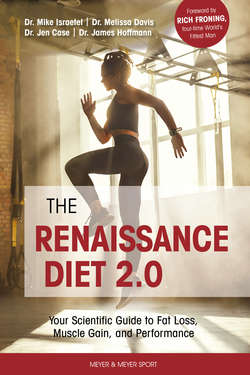Читать книгу The Renaissance Diet 2.0 - Mike Israetel, James Hoffmann - Страница 31
На сайте Литреса книга снята с продажи.
CALORIES AND BODY COMPOSITION
ОглавлениеBody composition describes how much muscle and fat makes up your body. Improving body composition usually refers to getting leaner, more muscular, or both. Conversely, poor body composition tends to mean low muscle mass, an unfavorable excess of fat, or both. As you might expect, the vast majority of diets attempt to improve body composition. Calorie balance is the single biggest tool for altering body composition.
Your body is primed by millions of years of evolution to prepare itself for impending famine, something that has been a feature of the human (and animal) experience for as far back as biologists can investigate. Millions of years of natural selection have left your body designed to store as much energy as possible to prepare for times of low food availability. When your body is exposed to the hypercaloric condition, it stores most of the excess energy as body fat. This is logical because in ancestral environments, times of plenty were inevitably followed by times of scarcity, and storing excess calories as fat in the former literally saved your life in the latter. If an athlete or dieter is on a hypercaloric diet today, the chances that their body will activate fat-burning pathways over fat-building pathways are quite low. When extra calories are around, fat gain is usually a result.
Muscle growth rates are much smaller than fat gain rates. This is again a side effect of our evolution. Muscle mass is metabolically costly; it requires more energy to build and maintain than fat mass. Thus, the body sees adding extra muscle as a survival disadvantage under most circumstances. Only when there is a pressing need (increasingly difficult weight-bearing tasks) and a steady hypercaloric condition will any significant muscle mass be gained and even then to a lesser extent than fat. It is not uncommon for people to lose 15 lb. of fat in three months in a hypocaloric condition, but gaining 15 lb. of muscle in the same timeframe under hypercaloric conditions is virtually impossible. In fact, 15 lb. would be an impressive amount of muscle to build even in your first year of training.
For muscle to grow, there are two fundamental requirements: 1) the energy and raw material (amino acids from protein–the building blocks for muscle) with which to fuel the building of the muscle. Just like a frugal family will not get a new deck added to their home unless there is more money coming in than is needed for food and to pay bills, the body will not activate muscle growth pathways to any large extent until excess calories and plenty of protein are coming in. And 2) the stimulation of muscle growth from proper overload training. For the body to be convinced that metabolically costly muscle mass is worth adding, the consistent need for that muscle mass must be presented in the form of increasingly difficult resistance training.
It might seem obvious that results from concurrent body recomposition–simultaneous fat loss and muscle gain–pale in comparison to losing fat and gaining muscle in separate phases. This is because the most powerful methods for fat loss and muscle gain are diametrically opposed. For fat loss to occur at best rates, a hypocaloric condition is needed. When a hypocaloric condition is detected by body systems, it primes and prepares fat burning precisely to make up the impending deficit. In contrast, for best muscle gain rates, a hypercaloric condition and weight gain are needed. When a surplus of energy is coming in, the body is less resistant to packing on some metabolically costly muscle along with fat for energy storage. An isocaloric diet is the midpoint of the two-principle calorie balance paradigms and is not a powerful stimulator of fat loss nor muscle growth. Because our best tools for each are literal opposites, combining them gives us neither of each. Simply, if your goal is muscle gain, generate a hypercaloric condition. If your goal is fat loss, generate a hypocaloric condition.
There are specific, albeit rare and limited, instances when recomposition does occur. As we discuss these cases, keep in mind impressive social media transformation stories you might have seen in the past, and how one or more of these circumstances may have been at play. Also consider that having recomposition as a goal in your own diet design is likely a fool’s errand in most cases, or at the very least not an efficient game plan.
